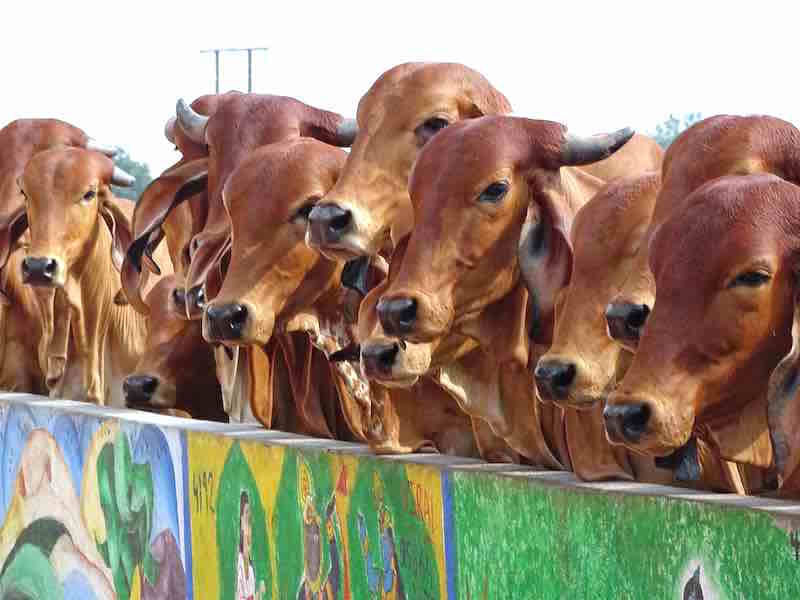India, a country in which 70% of people are involved in agriculture one way or another, has experienced an epidemic of farmer suicides in recent decades. The phenomenon is attributed to the difficulties of the occupation, which can range from monsoon failure to crop problems to money lending vultures. If that isn’t bad enough, now the farmers of India are being threatened by a new group: the cows themselves.
In Hinduism, the religion practiced by the majority of Indians, cows are considered sacred. They are honored for their gentle nature, which is congruent to the Hindu belief of not doing harm to animals. In addition, because they were historically an integrated part of Hindu society—providing dairy products, fertilizer and muscle for tilling—they are traditionally identified as a caretaker or maternal figure. While a large percentage of Hindus are vegetarians, nearly all of them abstain from eating beef.
Due to the reverence of the bovine, it was never uncommon to see a vagrant cow on the side of the road or walking through a city aimlessly. Nonetheless, Prime Minister Narendra Modi and his Bharatiya Janata Party (BJP) have pushed the country towards Hindu nationalism, installing radical monks in states like Uttar Pradesh. The result is that is has become difficult to legally cull or sell cattle. Traditionally, much of the cattle slaughtering and transportation was done by Muslims, as Islam, practiced by about 15% of the country, does not include similar beliefs regarding the veneration of the cow. The beef would be consumed by Muslims or shipped to other countries. Since the enforcement of Hindu beliefs in government, however, not only is hard for Muslims to engage in cattle dealing, but some have been injured or killed by “vigilantes” trying to protect the animals. Without the option to cull, farmers have been releasing their unproductive cattle.
Now there are cows everywhere.
The stray cows have gone from pests to a significant threat to the livelihood of farmers. Depending on crops on marginal land to survive, a farmer can have his entire income eaten or trodden on in hours by wandering herds. Consequently, they are forced to guard their fields day and night, going months with little sleep and falling into ill health. Many communities try to organize shifts in the winter, armed with sticks and a thermos of coffee. Nonetheless, in the Uttar Pradesh region alone there are over one million stray cows, and keeping them shooed away is no small task.
Farmers in the village of Edalpur decided to take action. Students of the local school went to class one morning to find that the classrooms were already occupied by several hundred cattle. The halls were soon filled with urine and manure, becoming a janitor’s worse nightmare. Feeling like their concerns were ignored by the government, farmers wanted to send a message. Soon, more than 15 other villages followed suit. Students were waking up everywhere in the region to find they had new classmates. Before long, cows were being locked up in various government buildings.
With elections looming in the spring, the government has vowed to deal with the problem. They imposed a 0.5 percent tax on roads to be used to build more shelters, called goshalas, for the cattle. Between 2014 and 2016 the Indian government spent $87 million on goshalas. Currently, while there are many sanctuaries set aside for the stray cows, they’ve quickly become filled up. Even getting the animals to the shelter can be an ordeal. One driver, transporting the cows from a school to a goshala, was attacked because a rumor was spread in a WhatsApp group that that the cows were being taken to slaughter.
Being neither Hindu nor Indian, it is difficult, and maybe inappropriate, to offer an opinion or speculation from outside the culture. Few of us in North America know the facets and intricacies of Hinduism. Perhaps it is an interesting example, however, of the complications that might arise in having religion dictate public policy. It gets messy when church and state mix, and problematic in serving the needs of the whole population. Maybe it’s another lamentable instance of a government not prioritizing the needs of the farmer, or, on the other side, an inspirational story of farmers taking action and creating change. Regardless, in India, it has simply added difficulty to an agricultural sector that is already known for being strenuous on those who participate in it. It is difficult to overlook the irony that the animal many farmers raise is both seen as a representation of gentleness while simultaneously terrorizing them.
This article is part of The Milk House Column series, published in print across three countries and two languages. It can also be found at themilkhouse.org.
This article appeared in a similar form in Progressive Dairyman and Farm and Livestock Directory.

